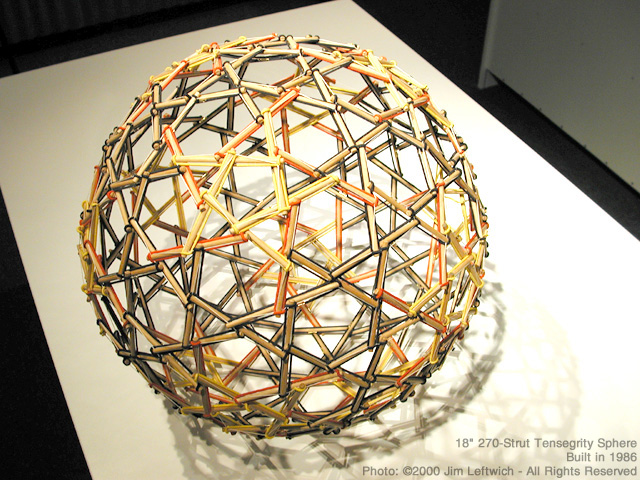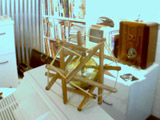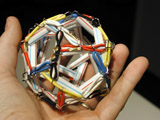
My
18" 270-Strut Tensegrity Sphere
I've got a lot of books by and about Buckminster Fuller. His ideas on
synergetics were original and predated many other works in system theory.
His geodesic structures are among the most amazing innovations in structural
thinking ever made and his work with tensegrity
greatly expanded that structural technology.
It is now widely acknowledged that the first discoverer of tensegrity
was Kenneth Snelson,
who had attended a number of lectures given by Fuller at Black Mountain
College during the summer of 1948. Both Snelson and Fuller later developed
the idea of tensegrity in unique and independent approaches and both
received patents for different embodiments, but it was Snelson who built
the first true tensegrity structure in the winter of 1948. He showed
this model to Fuller in the summer of 1949 - two "X"-shaped figures
suspended next to one another in a sea of tension. Snelson went on to
use tensegrity in his sculptures. Fuller built a large number of tensegrity
spheres as examples of his synergetics (what he then called "Engergetic
Geometry"), but always gave Snelson credit for the original insight.
More
on Snelson's role in the development of tensegrity...
Building tensegrity spheres completely changed my whole approach to
thinking about systems and patterns. Fuller is the epitomy of anti-right-angle
thinking.
 When
I was around eight years old in the late 1960s, I'd ordered a wooden
stick "puzzle" from the Sears Roebuck catalog that had a hand-blown
glass sphere in the middle. I now know that it was actually a 12-strut
tensegrity sphere, but not knowing that at the time, it was the photograph
in the catalog that was intriguing to me for its amazing pattern. The
term tensegrity was not mentioned in the catalog, and there were no
instructions on the secret of its patterned construction, nor notes
on Buckminster Fuller, nor any other leads to further information whatsoever.
Needless to say, it wasn't long before the sphere was just a pile of
struts that I could no longer re-assemble. Then, in the 1980s, after
studying the work of Fuller, the memory of this "puzzle" suddenly came
back to me. "Could that puzzle from long ago have been a tensegrity
structure?" I wondered. By some miracle, upon my next trip home, I found
the unassembled pieces still stored in a cabinet. Within a few minutes,
I'd reassembled the sphere with the glass ball inside.
When
I was around eight years old in the late 1960s, I'd ordered a wooden
stick "puzzle" from the Sears Roebuck catalog that had a hand-blown
glass sphere in the middle. I now know that it was actually a 12-strut
tensegrity sphere, but not knowing that at the time, it was the photograph
in the catalog that was intriguing to me for its amazing pattern. The
term tensegrity was not mentioned in the catalog, and there were no
instructions on the secret of its patterned construction, nor notes
on Buckminster Fuller, nor any other leads to further information whatsoever.
Needless to say, it wasn't long before the sphere was just a pile of
struts that I could no longer re-assemble. Then, in the 1980s, after
studying the work of Fuller, the memory of this "puzzle" suddenly came
back to me. "Could that puzzle from long ago have been a tensegrity
structure?" I wondered. By some miracle, upon my next trip home, I found
the unassembled pieces still stored in a cabinet. Within a few minutes,
I'd reassembled the sphere with the glass ball inside.
 Now
I was obsessed. I had to build more tensegrity spheres. (I continue
to build them. See the 30-strut
Soda Straw Tensegrity Sphere I recently built in just a couple of
hours, based on plans
by George Hart.)
Now
I was obsessed. I had to build more tensegrity spheres. (I continue
to build them. See the 30-strut
Soda Straw Tensegrity Sphere I recently built in just a couple of
hours, based on plans
by George Hart.)
I found a company, Design Science Toys,
selling a kit called Tensegritoy(tm)
with thirty tensegrity struts with elastic tensional elements. Tensegritoy(tm)
can be purchased
online and is a really simple and fun way to get involved with building
and experimenting with tensegrity structures. I had a lot of fun building
spheres with that kit, but I wanted something more complex. I briefly
considered purchasing a lot of kits, but quickly abandoned that idea,
as the cost would be prohibitive and the length of the struts (12" or
so) would create a sphere much too large and elastic than what I wanted.
So I decided that I would simply have to build one myself, from scratch.
The result of the subsequent project is my pride and joy, a 270-strut,
18" tensegrity sphere which I created over a couple of months back in
the summer of 1986. I'd seen pictures of them in books, but the images
were so complex that I couldn't discern the necessary pattern between
the struts. I had built some less complex tensegrity spheres, with 12
and 36 struts. So I decided that I'd begin by making the struts and
then experiment until I discovered the pattern that would yield a sphere.
I began with a lot of 36" wooden dowels, which I started by measuring
out into 4" segments. I marked them off with a pen. Next I took an X-Acto
knife and with a rolling back and forth movement, cut them into separate
little lengths. I then measured out tiny lines at the ends of each of
these 270 struts and used my Dremel Tool with a tiny saw bit to cut
1/4" slits into the ends of each strut. I then cut 270 lengths of nylon
twisted kite cord. Each cord (which would serve as the tensional element)
was stretched through first one of the slots in a strut, then pulled
down and around and stretched through the opposite slot. When I was
finished doing this for all 270 struts, I then turned on an electric
burner on my stove, and with a ventilating fan blowing, melted off the
extra cord at each end, sealing on the tensional elements.
Next came the meditative part. I had 270 struts, each the same. I knew
that some pattern would bring them into a sphere (a whole) but I didn't
know what the pattern was. Construction is accomplished by using the
slots at the end of each strut to "hook into" the tensional element
of another strut, while two other struts are hooked into the first strut,
and so on.
I experimented each night. Regular patterns led to strange, warping
sheets and I had to tear it all apart and start again. Then one evening
I hit upon the idea of using the pattern of five struts arranged around
each other and separated by two groups of six. Voila! The sphere began
to come together. It was one of the most amazing examples of Satori
I've ever experienced. I really believe that the whole process changed
my entire paradigm of thinking.
Later on, I used Black, Red, And Yellow hairbands to highlight the pattern
in the sphere and I have it displayed in my office. I consider it my
most sacred object.
Here's a detailed
closeup photo diagram of my 270-strut tensegrity sphere which may
help in understanding the construction configuration of the struts and
tensional elements.
I used the VideoCAMworks
software that I designed for Kensington
to create a QuickTime stop-motion animation of two tensegrity spheres
I'd constructed back in the 1980s, and the original tensegrity sphere
with the hand-blown glass ball that I'd gotten as a child. "Ballet
du Buckminster"
Here's a good link to show how these are arranged into a 270-strut sphere:
http://www.bfi.org/Tesgt_pd_rdl.jpg
Now if you look at the snapshot of my sphere, it might be a little bit
clearer as to the structure. You might also see why it was so difficult
for me to build, even though I knew some of the simple ideas behind
tensegrity. It's awfully easy to get visually confused when trying to
read one of these photos or diagrams and to this day, it's difficult
for me to draw an assemblage of tensegrity elements.
It may sound like a somewhat hyperbolic statement to say I consider
my sphere a "sacred object." But I really do feel that way. I consider
it sacred for a number of reasons, not the least of which was the transformation
that I underwent when building it, but also for its perfect embodiment
of the idea of wholeness emerging from a pattern of consituent elements.
Tensegrity, to me, is the ultimate symbol of "holding hands." It is
not a rigid structure, such as a geodesic dome. As such, a properly
vibrationally-dampened tensegrity structure would be the perfect structure
for outer space.
I had an epiphany of sorts, when building the sphere. I had a vision
of people in a circle holding hands. As the people pulled their hands
in (pulling inward / self-interest), the circle (system) contracted.
It didn't contract to an infinite degree, but it definitely became smaller
overall. But when the people extended their arms and hands as far as
possible, while still holding hands, the circle (system) expanded to
its true potential. As with pulling inward, the expanded size of this
circle was not infinite, but instead represented the greatest possible
potential. This, probably more than any other metaphor, is how I see
humanity. Today, we are a circle, but there are too many of us pulling
our arms inward, hence in total we have not expanded to our possible
potential. The open source movement (and Linus Torvalds) understand
this concept. So did the Red Hot Chili Peppers (Give it away, give it
away, give it away, give it away now...)
My tensegrity sphere is an embodiment of this truth for me, and as such,
I find it more sacred than any other spiritual symbol I've run across
or had shoved at me. Just a thought...
And herein lies an incredible irony regarding different philosophies
that I value parts of, sometimes for reasons quite differently than
most people.
On one hand, you can see that I embrace a form of what might be seen
as altruism, in that I believe that in order for the system as a whole
(and in turn each of the consituent elements) to benefit from the system's
maximum potential, each constituent element must contribute as much
as possible in a selfless manner. On the other hand, I agree with Ayn
Rand regarding the uniqueness of the individual, not so much as she
probably extrapolated, but more in that I realize that in our present
condition and state, nobody except for extremely insightful individuals
can grasp why these higher orders of cooperation yield better results,
both for individuals and the system as a whole.
Marx most likely intuited a form of this as well, but as you can see
from history, insight alone is not sufficient to stand in for the system
complexity, interconnection, and energy needed to actually reach this
higher state in a naturally emergent and non-forced manner. Attempts
to "make this happen" are doomed to failure. It has to emerge naturally,
and I believe it will in time. And so, I believe for the short term,
we are, most likely and unfortunately, stuck at this lower energy state.
But network and communicational technologies offer what I feel are the
best hope for moving towards this.
email Jim Leftwich
Synergetics,
Tensegrity, and Related Links
A detailed
closeup photo diagram of my 270-strut tensegrity sphere which may
help in understanding the construction configuration of the struts and
tensional elements.
This paper, TENSEGRITY:
By R. Buckminster Fuller appeared in
Portfolio and Art News Annual, No.4, 1961.
Visit the Buckminster Fuller Instititute,
an organization devoted
to advancing Humanity's Option for Success.
My friend and neighbor, Robert Gillis, founder of Shelter
Systems,
has pioneered the development of tensegrity
and geodesic tent
structures for over twenty years.
Kirby Urner maintains the incredibly comprehensive Synergetics
on the Web Site, which has a good page on Kenneth
Snelson
Build your very own tensegrity structure! See George
Hart's
amazingly cool Soda
Straw Tensegrity Structures Page. Here's a
30-strut
Soda Straw Tensegrity Sphere I built.
Everyone and everything at Fluidiom
is interesting and cool! This
site covers everything from memetics to tensegrity.
You'll find all kinds of synergetic geometry images and animations
at Richard Hawkins'
Digital Archive.
The great links at David Eppstein's Geometry
Junkyard are
anything but junk!
Flemming Funch has a great link-listing page devoted to Whole
Systems, which includes nearly forty essays he's written on related
subjects.
Jim Nystrom's
hyperlinked paper In
Search of: Computational
Cosmography ties a lot of things together very intelligently, and
includes a section on tensegrity.
Joe Moore maintains the Buckminster
Fuller Virtual Institute
including pages on tensegrity
and Domes